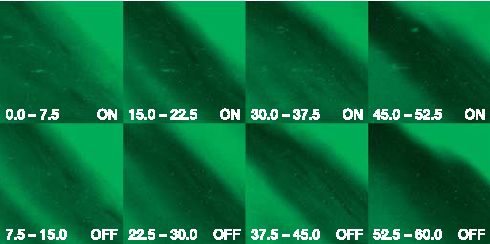First Artificial Neon Sky Show Created

By shooting intense radio beams into the night sky, researchers created a modest neon light show visible from the ground. The process is not well understood, but scientists speculate it could one day be employed to light a city or generate celestial advertisements.
Researchers with the High Frequency Active Auroral Research Program (HAARP) project in Alaska tickled the upper atmosphere to the extent that it glowed with green speckles.
The speckles were sprinkled amid a natural display known as the aurora borealis, or Northern Lights. The aurora occurs when electrons from a cloud of hot gas, known as plasma, rain down from space and excite molecules in the ionosphere, about 30 miles (50 kilometers) up.
The HAARP experiment involves acres of antennas and a 1 megawatt generator. The scientists sent radio pulses skyward every 7.5 seconds, explained team leader Todd Pederson of the Air Force Research Laboratory.
"The radio waves travel up to the ionosphere, where they excite the electrons in the plasma," Pederson told LiveScience. "These electrons then collide with atmospheric gasses, which then give off light, as in a neon tube."
Pederson and his colleagues missed the show, but they snapped images.
"We unfortunately were indoors watching the data on monitors during the experiment and were busy scrambling trying to make sure the effects were real and not some glitch with the equipment," he said. "We knew right away it was something extraordinary to show up in real time on the monitor against the natural aurora, but did not confirm that it would have been visible to the naked eye until a day or two later when we had a chance to calibrate the raw data."
Get the world’s most fascinating discoveries delivered straight to your inbox.
The experiment is detailed in the Feb. 2 issue of the journal Nature.
The research could improve understanding of the aurora and also help explain how the ionosphere adversely affects radio communications.
It is not yet clear if the aurora must already be active before an artificial sky show can be induced, says Karl Ziemelis, chief physics editor at the journal.
If no pre-existing aurora is required, Ziemelis said, "we are left with the tantalizing (some would say disconcerting) possibility that such radio-fuelled emissions could form the basis of a technology for urban lighting, celestial advertising, and more."
Robert is an independent health and science journalist and writer based in Phoenix, Arizona. He is a former editor-in-chief of Live Science with over 20 years of experience as a reporter and editor. He has worked on websites such as Space.com and Tom's Guide, and is a contributor on Medium, covering how we age and how to optimize the mind and body through time. He has a journalism degree from Humboldt State University in California.

